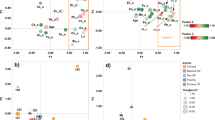Abstract
The relationship between occupational exposure to methyl ethyl ketone (MEK) and its concentration in urine and blood was studied in a group of 72 workers in a printing factory. Personal exposure monitoring was carried out with passive samplers during the workshifts. The time weighted average (TWA) concentration of MEK ranged from 1.3 to 223.7 ppm, with a mean concentration of 47.6 ppm. In addition to MEK, toleuene, xylene, isopropyl alcohol, and ethyl acetate were detected as the main contaminants in all samples.
At the end of the workshift, urine samples were collected to determine the urinary MEK, hippuric acid (HA), and creatinine, and blood samples were also collected at the same time for determination of MEK. The concentrations of urinary MEK ranged from 0.20 to 8.08 mg/L with a mean of 1.19 mg/L and significantly correlated with TWA concentrations of MEK in the air with a correlation coefficient of 0.889 for uncorrected urine samples. The concentration of MEK in the blood was also significantly correlated with the TWA concentration of MEK with a correlation coefficient of 0.820.
From these relationships, MEK concentrations in urine and blood corresponding to the threshold limit value-TWA (200 ppm; ACGIH 1992) were calculated to be 5.1 mg/L and 3.8 mg/L as a biological exposure index (BEI), respectively. Although the BEI for urinary MEK obtained from the present study was higher than that of previous reports and ACGIH's recommendation (2.0 mg/L), the BEI agreed well with a previous study in Japan. On the other hand, the relationship between toluene exposure and urinary HA level, an index of toluene exposure, was also studied at the same time. The urinary concentration of HA corresponding to TWA at 100 ppm was 2.6 g/g creatinine as BEI. This value agreed well with both ACGIH's recommendation (2.5 g/g creatinine) and the values reported by Japanese researchers who have studied Japanese workers. Ethnic differences of MEK metabolism may affect the relationship between exposure and BEI.
Similar content being viewed by others
References
American Conference of Governmental Industrial Hygienists (1992) Threshold limit values of chemical substances and physical agents and biological exposure indices, ACGIH, Cincinnati, OH
Anders MW (1988) Bioactivation mechanisms and hepatocellular damage. In: Arias IM, Jakoby WB, Popper H, Schachter D, Schafritz DA (eds) The liver: Biology and pathology. Raven Press Ltd, NY, pp 389–400
Brady JF, Li D, Ishizaki H, Lee M, Ning SM, Xiao F, Yang CS (1989) Induction of cytochromes P450IIE1 and P450IIB1 by secondary ketones and the role of P450IIE1 in chloroform metabolism. Toxicol Appl Pharmacol 100:342–349
Dietz FK and Traiger GJ (1979) Potentiation of CCI4 of hepatotoxicity in rats by a metabolite of 2-butanone: 2,3-butanediol. Toxicology 14:209–215
Fiserova-Bergerova V (1990) Application of toxicokinetic models to establish biological exposure indicators. Ann Occup Hyg 34:639–651
Ghittori S, Imbriani M, Pezzagno G, Capodaglio E (1987) The urinary concentration of solvents as a biological indicator of exposure: Proposal for the biological equivalent exposure limit for nine solvents. Am Ind Hyg Assoc J 48:786–790
Hewitt WR, Miyajima H, Cote MG, Plaa GL (1980) Modification of haloalkane-induced hepatotoxicity by exogenous ketones and metabolic ketosis. Fed Proc 39:3118–3123
Ikeda M, Ohtsuji H (1969) Significance of urinary hippuric acid determination as an index of toluene exposure. Br J Ind Med 26:244–246
Inoue O, Seiji K, Watanabe T, Kasahara M, Nakatsuka H, Yin S, Li G, Cai S, Jin C, Ikeda M (1988) Mutual metabolic suppression between benzene and toluene in man. Int Arch Occup Environ Health 60:15–20
Jang JY, Kang SK, Chung HK (1993) Biological exposure indices of organic solvents for Korean workers. Int Arch Occup Environ Health 65:S219-S222
Japanese Association of Industrial Health (1993) Recommended permissible concentration. Jpn J Ind Health 35:323–331
Liira J, Riihimaeki V, Engstrom K (1990) The effect of ethanol on the kinetics of methyl ethyl ketone in man. Br J Ind Med 47:325–330
Liira J, Riihimaeki V, Pfaffli P (1988) Coexposure of man to m-xylene and methyl ethyl ketone. Scand J Work Environ Health 14:322–327
Miyasaka M, Kumai M, Koizumi A, Watanabe T, Kurasako K, Sato K, Ikeda M (1982) Biological monitoring of occupational exposure to methyl ethyl ketone by means of urinalysis for methyl ethyl ketone itself. Int Arch Occup Environ Health 50:131–137
Ogata M, Taguchi T (1986) Quantitative analysis of urinary glycine conjugates by high performance liquid chromatography: Excretion of hippuric acid and methyl hippuric acids in the urine of subjects exposed to vapours of toluene and xylenes. Int Arch Occup Environ Health 58:121–129
— (1987) Quantitation of urinary metabolites of toluene, xylene, ethylbenzene, benzene and phenol by automated high performance liquid chromatography. Int Arch Occup Environ Health 59:263–272
— (1988) Simultaneous determination of urinary creatinine and metabolites of toluene, xylene, styrene, ethylbenzene, and phenol by automated high performance liquid chromatography. Int Arch Occup Environ Health 61:131–140
Ong CN, Sia GL, Ong HY, Phoon WH, Tan KT (1991) Biological monitoring of occupational exposure to methyl etyl ketone. Int Arch Occup Environ Health 63:319–324
Pagnotto LD, Lieberman LM (1967) Urinary hippuric acid excretion as an index of toluene exposure. Am Ind Hyg Assoc J 28:129–134
Perbellini L, Brugnone F, Mozzo P, Cocheo V, Caretta D (1984) Methyl ethyl ketone exposure in industrial workers. Uptake and kinetics. Int Arch Occup Environ Health 54:73–81
Ronis MJJ, Ingelman-Sundberg M (1989) Acetone-dependent regulation of cytochrome P-450j (IIE1) and P-450 (IIB1) in rat liver. Xenobiotica 19:1161–1165
Saida K, Mendell JR, Weiss HS (1976) Peripheral nerve changes induced by methyl n-butyl ketone and potentiation by methyl ethyl ketone. J Neuropathol Exp Neurol 35:207–225
WHO (1992) Environmental health criteria 143: Methyl ethyl ketone. World Health Organization, Geneva
Author information
Authors and Affiliations
Rights and permissions
About this article
Cite this article
Yoshikawa, M., Kawamoto, T., Murata, K. et al. Biological monitoring of occupational exposure to methyl ethyl ketone in Japanese workers. Arch. Environ. Contam. Toxicol. 29, 135–139 (1995). https://doi.org/10.1007/BF00213098
Received:
Revised:
Issue Date:
DOI: https://doi.org/10.1007/BF00213098




